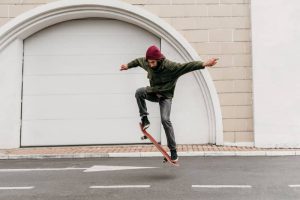Skateboarding, skater styles, and skateboarding culture have existed for over half a century now. With so much history and decades of fashion and culture, skateboarding clothes have changed over the years. Whether your parents or grandparents were skaters or not, the boarders of their generations dressed a little differently than those today.
To celebrate skateboarding fashion history and to give you some major inspo for current fits, we have put together a timeline of skater style over the past 50-plus years.

(freepik/Freepik)
The ‘70s
Skater culture was born in 1970s California. The decade’s laid-back vibes and skateboarding’s chill, counter-culture vibe went together well. That said, the outfits of the California hippie were a far cry from what we picture with skate style today.
Skaters paired tiny shorts and long socks with tighter tees and tank tops. Surfers who called the area home at the same time certainly influenced the look. After all, many skaters then were just surfers looking to “catch a wave” on land.
If they weren’t wearing shorts, the ’70s skater wore a pair of distressed, ripped jeans. Long, flowy hair was icing on the cake for the laid-back, carefree feel of the 70’s skater, complementing the feeling of the whole decade.
The ‘80s
Right on the heels of the hippie generation came a significant shift in skater style. Skaters like Tony Hawk began showing off skater baggy outfits in the 1980s, which later became synonymous with skateboarding culture.
Pictures of Tony Hawk from the era often show him in cargo shorts below his knees and an oversized skate t-shirt layered over a long-sleeved shirt. These baggy fits allowed greater mobility and comfort when attempting more complex tricks. Not everything was a sharp turn from the ‘70s, however. Hippie roots were honored with the continued use of long tube socks.
The ‘80s also saw the popularization of the Vans skate sneaker. The flat, durable sole was perfect for holding up to the wear and tear of avid skaters, and the shoe became a wardrobe staple for every skater of the time.
During this decade, skateboarding started mixing more with counter-culture and rebellious influences. Punk-rock and rap cultural elements began making their way into skate style, with darker colors, leather, and studs becoming popular details in many ‘80s fits.
The ‘90s
After the major changes of the ‘80s, the ‘90s saw skate style becoming a more popular aesthetic across the board. The baggy fits stuck around, but more colorful and patterned skateboarding shirts started appearing everywhere.
Flannels and graphic skateboarding t-shirts were popular at the time, and skaters adopted this fashion trend. Skater culture and street culture began to mix, and the era of street skating took off like never before.
Heavy-duty fabrics and sturdy shoes became even more important to skaters, as falling on pavement meant some pretty gnarly scrapes. Thick fabrics, in addition to baggy clothes, helped to protect skin from getting too cut up when trying new tricks on the street.
Skate brands and styles also began to find their way into the mainstream fashion scene. You could find oversized jeans and Vans shoes in the closets of many young people of the time, skater or not.
The 2000s
The turn of the century also saw a slight return to the slimmer lines of early skate culture. Slimmer-fit chinos, jeans, and cargo pants made their way into outfits more frequently. Many brands started catching on to the rise in skater style and adding to their collections. Nike released the SB line targeted to skateboarders, and the SB shoe became a must-have of the decade.
Traditional skater brands continued success from the ‘90s and became widely available in shopping malls nationwide. Oversize skater hoodies and baggy skater shirts remained popular despite pants slimming down.
As with the ‘80s and ‘90s, music was a massive part of skate culture. Those who listened to rap and grunge were likely to stick to the baggy bottoms of the previous decades, while those listening to contemporary punk and pop gravitated towards slimmer styles.
The 2010s
The divide between baggy and slim skate fits continued into the next decade. As skating gained more and more popularity, the diversity of skate styles began to develop. Skating was no longer a sub-cultural movement. Skateboarding and skate culture were now popular pastimes that many young and older people wanted to be a part of.
Baggy fits remained an ode to skaters past and continued to be inspired by famous skaters who gained recognition in the X Games and Thrasher Magazine.
The 2020s and beyond
The current decade started with a bang, and COVID lockdowns meant more time for outdoor skating and more social media exposure for skateboarders of all levels. The sport attracts young and old, and skater kids clothes are a huge current fashion trend.
Wide-leg silhouettes, cargo pants, and big jeans have taken over major fashion cities, social media, and runways, with skinny-cut clothing becoming a thing of the past. Skate style is rooted in originality, individual expression, and comfort, and these factors continue to bring many new people in.
